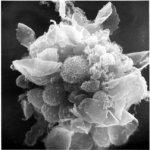The CD4 binding site on the gp120 portion of the envelope protein of HIV-1 is a vulnerable site, that when targeted could cripple viral entry into target cells. The recent edition of PloS Pathogens described isolation of new anti-HIV-1 CD4 binding site broadly neutralizing antibodies (bNAbs) and the authors provide information about viral escape mechanisms. The authors describe a new anti-HIV-1 bNAb that was isolated from an HIV-1 infected donor. The antibody targets the CD4 binding site in a glycan-dependent manner, which is quite an unusual characteristic for anti-HIV-1 CD4 bNAbs targeting the binding site.
The authors asked the question of whether this antibody could neutralize HIV-1 in vivo. They used humanized mice and infected then with HIV-1YU2 and then treated them with the new antibody three weeks later. Viral load dropped immediately after treatment followed by an increase in viral load. This viral rebound was associated with specific escape mutations in the plasma virus envelope and in some cases a shift in the glycan shield. Similar signature mutations were found in the envelope of the autologous virus cloned from patient’s plasma.
This paper shows that the humanised mouse is a good model to show that the antibody can suppress viral load, but also exerts selection pressure to allow the emergence of viral variants.
